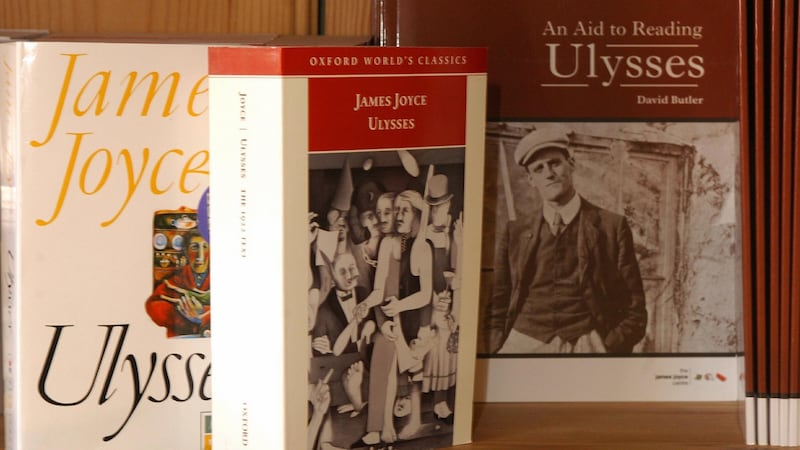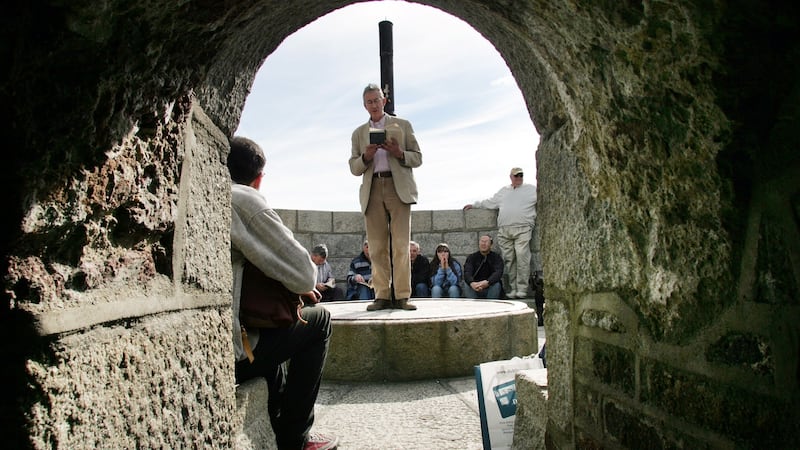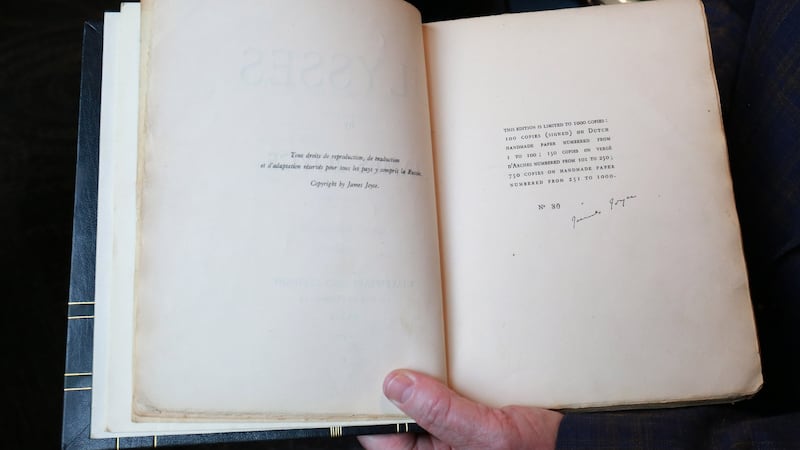It is customary these days, when discussing a book or film to issue a plot spoiler alert. In the case of Ulysses, a no-plot spoiler alert may be more appropriate. If you’re used to reading thrillers, be warned: not all that much happens in James Joyce’s masterpiece.
It follows ordinary people doing mostly ordinary things as they wander around Dublin on a June day in 1904: the day that, in real life, the author first went out with his future wife, Nora Barnacle. Starting 10 years later, after he had left Ireland for good, he immortalised their romance by recreating the city as it was that day.
Insofar as he had a plot, it was borrowed from Greek mythology, especially the Odyssey. The 18 chapters, or strictly speaking “episodes”, are loosely based on the misadventures of Odysseus/Ulysses as he makes his way home from the Trojan war to his wife (Penelope) and son (Telemachus).
You don't have to be familiar with Homer's original to enjoy the story

The banality of events in Dublin just adds to the joke. But you don’t have to be familiar with Homer’s original to enjoy the story. Nor do you need to know that, as well as writing the book in many different styles, Joyce also gave each episode a sub-theme involving colours, symbols, parts of the body, branches of science and more.
That detail emerges with re-reading, and can become an obsession if you’re not careful. In the meantime, those attempting the book for the first time may benefit from an episode-by-episode summary.
1 Telemachus
There is a case to be made, if you're new to Ulysses, for skipping the first three chapters. But assuming you do want to start at the start, it helps not to expect much from these. Part of their problem is that they are dominated by Joyce himself, in the person of his thinly disguised alter ego, Stephen Dedalus.
Dedalus is a gloomy young intellectual, about to become homeless after a troubled night in his temporary lodgings, the Martello Tower, where the book begins. Ernest Hemingway thought that, of the two main characters in Ulysses, Leopold Bloom was far more interesting because he was fictional, whereas Dedalus had too much of Joyce's own neuroses to come alive. In any case, we're stuck with Stephen for now. Bloom doesn't enter the action until chapter four.
2 Nestor
The scene moves to a school in Dalkey, where Stephen teaches literature and history while being gloomily introspective. The headmaster, Mr Deasy, dispenses his pay and casual anti-Semitism. He also gives him a letter about the treatment of foot-and-mouth disease, which he hopes Stephen will get his newspaper friends to publish.
3 Proteus
Stephen walks into the city along Sandymount Strand, thinking intellectual thoughts about the “ineluctable modality of the visible” (dependency on sight to interpret the world). He also reflects on the greenness of the sea and, developing the colour theme, picks his nose.

4 Calypso
Not a moment too soon, our hero makes his entry, over breakfast at his home on Eccles Street. Leopold Bloom is not much of a hero: a 38-year-old advertising canvasser whose marriage has never recovered from the death of his infant son and whose wife is now having an affair with her singing manager, a fact of which Bloom is painfully aware. He’s no intellectual, either. But his inner voice, which will be with us for most of the book, is much more congenial company than Stephen’s.
5 Lotus-Eaters
The episode that launched a million sales of lemon soap. Bloom wanders into town, visiting Sweny’s Chemist among other errands. He inadvertently tips the winner of the Ascot Gold Cup, scheduled later in the afternoon, setting himself up for sectarian abuse as the descendant of a Jewish immigrant (although his father converted to Protestantism and Bloom himself is now a Catholic).
6 Hades
In the Odyssey, Ulysses descends into the underworld to seek guidance from a prophet. Bloom visits the Dublin equivalent, Glasnevin Cemetery, for the funeral of Paddy Dignam. He asks the newspaper reporter present to include in the attendance list a friend who couldn't make it. Typically, the journalist later spells correctly the name of the man who wasn't there while getting Bloom's name wrong.
7 Aeolus
One of Joyce’s more obvious exercises in writing style, this one has Stephen, Bloom and others converging in the offices of the Freeman’s Journal and Evening Telegraph, while the action (or lack of it) is broken into news-story-size nuggets, with headlines.
8 Lestrygonians
A tale of two pubs, as Bloom considers having lunch in Burton’s Restaurant (where The Bailey now stands), but is revolted by the sight of people eating like animals, so crosses Duke Street and instead has a civilised glass of wine and cheese sandwich in Davy Byrne’s, which still basks in the glory today. Other winners from the episode include The Irish Times, noted in passing by Bloom to be the “best paper by long chalks for a small ad”.

9 Scylla and Charybdis
This is one of two episodes I strongly advise first-time readers to skip, or skim, unless they’re being really conscientious. It’s set in the National Library and is dominated by Stephen having an extremely clever idea about Shakespeare’s Hamlet. Don’t worry: the subject is never going to come up at a dinner party.
10 Wandering Rocks
A justly celebrated episode, this is the book in microcosm, as the characters criss-cross Dublin in 18 vignettes, with Joyce co-ordinating their movements like a watch-maker. In its final flourish, the vice-regal carriage leaves Phoenix Park and shoots through the city like an arrow, momentarily freezing everyone it passes in time and space.
11 Sirens
Two barmaids in the Ormond Hotel play the mythological sirens, whose song can fatally enrapture. Bloom’s real danger, meanwhile, is the impresario Blazes Boylan, who slips away quietly for Eccles Street, where the only character who has stayed at home all day awaits him eagerly.
12 Cyclops
Another famous chapter, set in Barney Kiernan’s pub, where “the Citizen” (based in part on GAA founder Michael Cusack) plays the one-eyed monster of mythology. Bloom is widely rumoured to have profited from the 20-1 winner of the Gold Cup and is now found guilty of one of Ireland’s worst social crimes: failure to put a hand in his pocket while on a licensed premises.
13 Nausicaa
The book itself has not reached a climax yet, but that is now more than we can say for Leopold Bloom, after an impromptu peep show on Sandymount Strand, involving Gertie MacDowell’s garters, proves too much for him.
14 Oxen of the Sun
Even if you made it through the library episode, you may want to think twice about this one, which is set in Holles Street hospital and will have faint-hearted readers pleading for an epidural. Bloom drops in to inquire about Mrs Purefoy, who is suffering a long-drawn-out and painful labour, while Stephen and his off-duty medical friends, including Buck Mulligan, enjoy a drunken party. An obvious sub-theme is the science of gestation. But for less obvious reasons, Joyce also treats us to a miniature history of English, from its earliest recorded forms to the 20th century, his narrative style changing with ever-increasing frequency. In happier news, Mrs Purefoy has a boy.
15 Circe
In The Odyssey, Circe turned Odysseus’s men into swine. Here, she runs a brothel in Monto, dubbed “Nighttown”, in Joyce’s most raucous chapter. Stephen gets into a drunken fight with an English soldier, while Bloom’s sexual humiliation at the feet of a dominatrix happens entirely in his own head.
16 Eumaeus
The main protagonists are tired and so, suddenly, is the book’s language. Written almost entirely in cliche (perhaps as the way Bloom would write if he tried), Eumaeus is set in a Cabman’s Shelter, run by the notorious Skin-the-Goat Fitzharris, cab-driver to the Phoenix Park Murders, as our heroes recover from their Monto ordeal.
17 Ithaca
Another tour-de-force from Joyce, describing the return to Eccles Street of Bloom and his replacement son, Stephen. The episode is written in Socratic Dialogue, with 309 question-and-answer segments reviewing the events of the journey and day in comically scientific language.
18 Penelope
Probably the most famous section, if not the most read. A daunting, densely packed 42 pages (in my edition), almost devoid of punctuation, it is Molly Bloom’s interior soliloquy on life, love, adultery and many other things. A recent edition of Ulysses, Robert Gogan’s “remastered” version (2012), had the radical idea of inserting full stops, commas and paragraph breaks. But if you’ve got this far in the book, you can probably brave jumping in at the deep end of Molly’s stream of consciousness. It will only add to the sense of achievement when you finally reach the celebrated last line. No need for a spoiler alert there either. You know it already: “...and yes I said yes I will Yes.”



















